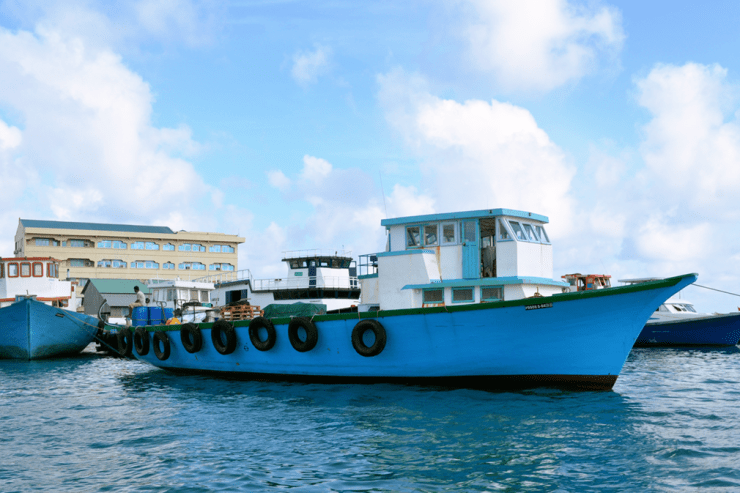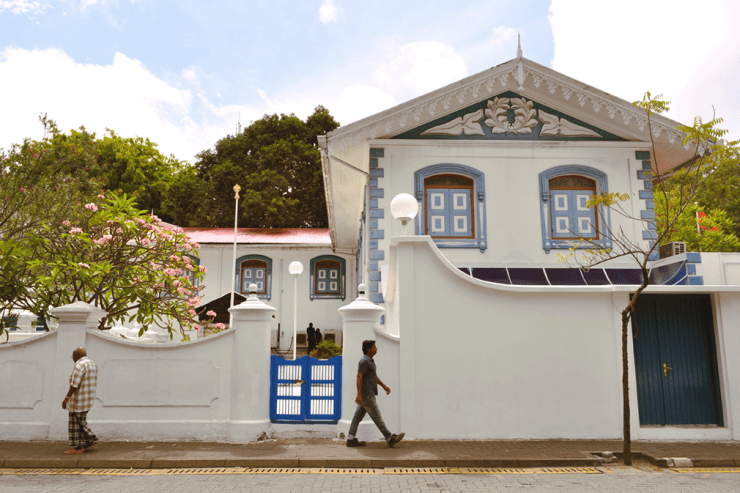A garland of islands cast into the middle of the ocean, hundreds of leagues away from the nearest landfall—it is difficult to believe that anyone had ever managed to reach the shores of the Maldives by boat. First settled by fishermen from the coasts of present-day India and Sri Lanka, the atolls were ruled for centuries by successions of chieftain-queens and Buddhist kings before becoming a sultanate and, later, a British protectorate.

In ancient times, the islands were known for their cowry shells, coconuts, and fish. Large shipments of Maldivian cowries made their way to China and Africa, where they were used as currency. Today, the economy is driven by a combination of tourism, fishing, and shipping.
Malé
With an area of just under six square kilometers, Malé is one of the world’s most densely populated cities. From a distance, the coral capital gives the illusion of having been built on nothing but water.

The Maldives came under British protection from 1887 to 1965, during which time the Mulee’aage Palace was built. The building, modeled after the colonial-era bungalows of British Ceylon, was originally commissioned by the sultan and intended for his son, the prince.

During the 1920s and early half of the 1930s, the palace was known throughout Malé for its celebrations and festivities. The decades that followed, however, were marred by upheavals and turmoil, and Mulee’aage gradually fell into disuse. In 1968, three years after gaining independence from Britain, a national referendum was held to abolish the sultanate. The Maldives proclaimed itself a republic, and Mulee’aage became the Presidential Palace.

Next to the jetties on Malé’s north shore, the Maldivian national colors fly proudly over Republic Square: a red field to represent the courage and the blood shed by the country’s heroes; a green rectangle for peace and the islands’ abundant greenery; and a white crescent, symbolizing a people united by a common faith.

Islam arrived on the islands by way of Arabic traders sailing from the Middle East and possibly Morocco. In the 12th century, the last Buddhist king of the atolls converted to Islam, and the people followed suit. On locally inhabited islands, mosques are the cornerstones of the community, and prayer sessions are held five times per day. In Malé, the Grand Friday Mosque, together with its intricate minaret, has become a celebrated city landmark.

The Maldives is Asia’s smallest country in land and population. Yet, comprising over a thousand coral islands covering 90,000 square kilometers, it is one of the world’s most geographically dispersed countries.
Mahibadhoo
A two-hour speedboat ride (or alternatively, a five-hour ferry ride) to the southwest of Malé is the sleepy island of Mahibadhoo.

Measuring less than a single kilometer in length, it only takes twenty-five minutes to stroll the entire circumference of the island. Despite its size, Mahibadhoo is home to 2,000 people. Many of the local young men work on nearby resorts, and the remainder of the residents are employed in fishing, handicrafts, boat building, construction, and carpentry.

Rising water levels put the country—the flattest in the world—on the front line of climate change. While the government is looking into various engineering projects to secure the islanders’ future on the atolls, for now, ashore the beaches of another world, life is lush and calm.
Twenty-five minutes by boat from Mahibadhoo is a deserted island. It has no name, no possibility of ever being found again other than in the recess of a reverie.

Above the waters, the only signs of life were low-growing shrubs of beach cabbage and a single palm tree. But below the transparent surface, all was in full bloom. Coral beds housed bright pinpricks of color and shoals of fish swam to and fro.

As the evening fell and the temperature dipped, we felt the heat radiating off our own bodies—flushed from an afternoon under a blazing, tropic sun. The winds stilled and their billows were soon replaced by high-pitched whines of hungry mosquitoes.

Over our heads, the stars danced across a velvet sky. Beneath us, something remarkable and otherworldly was happening. The sand around our feet began to emit a spectral glow. We ran along the shoreline in the dark of the night and watched as tiny, neon cerulean flecks of bioluminescent plankton followed and lit up our trails. After for what seemed like an hour marveling at their wonders, we retreated to the warmth of a small bonfire to wait out the beginning of a new, unpredictable year.
